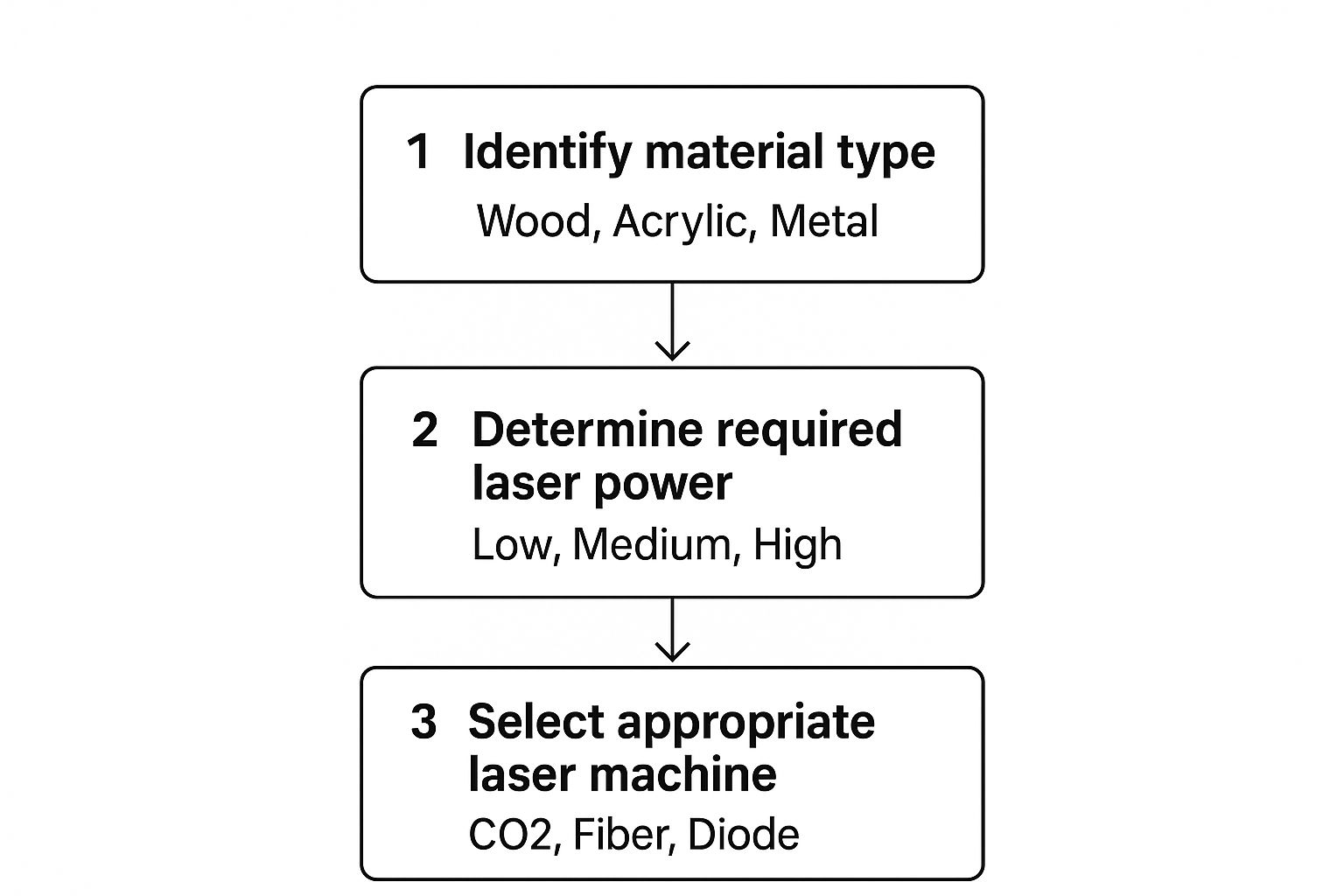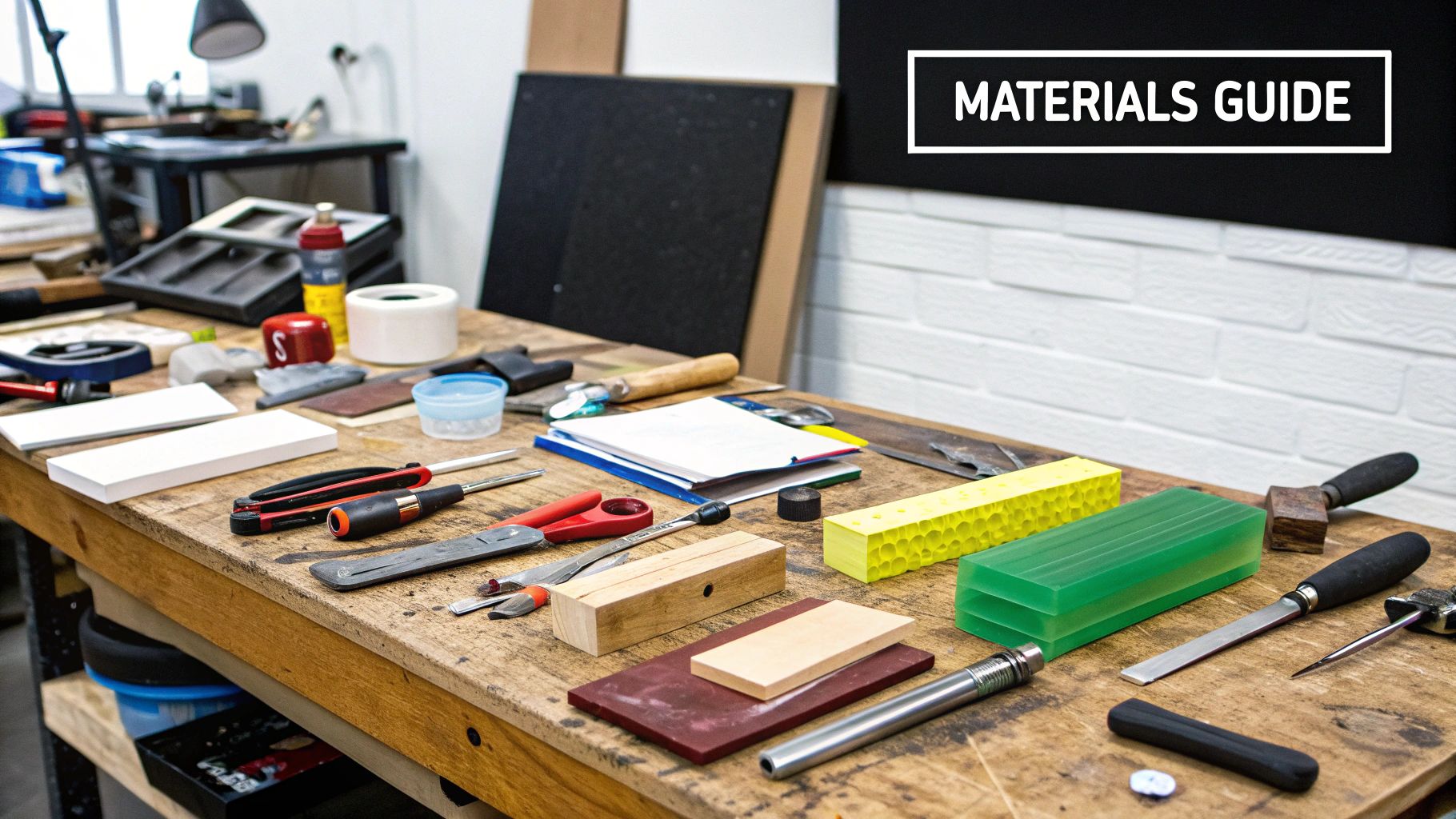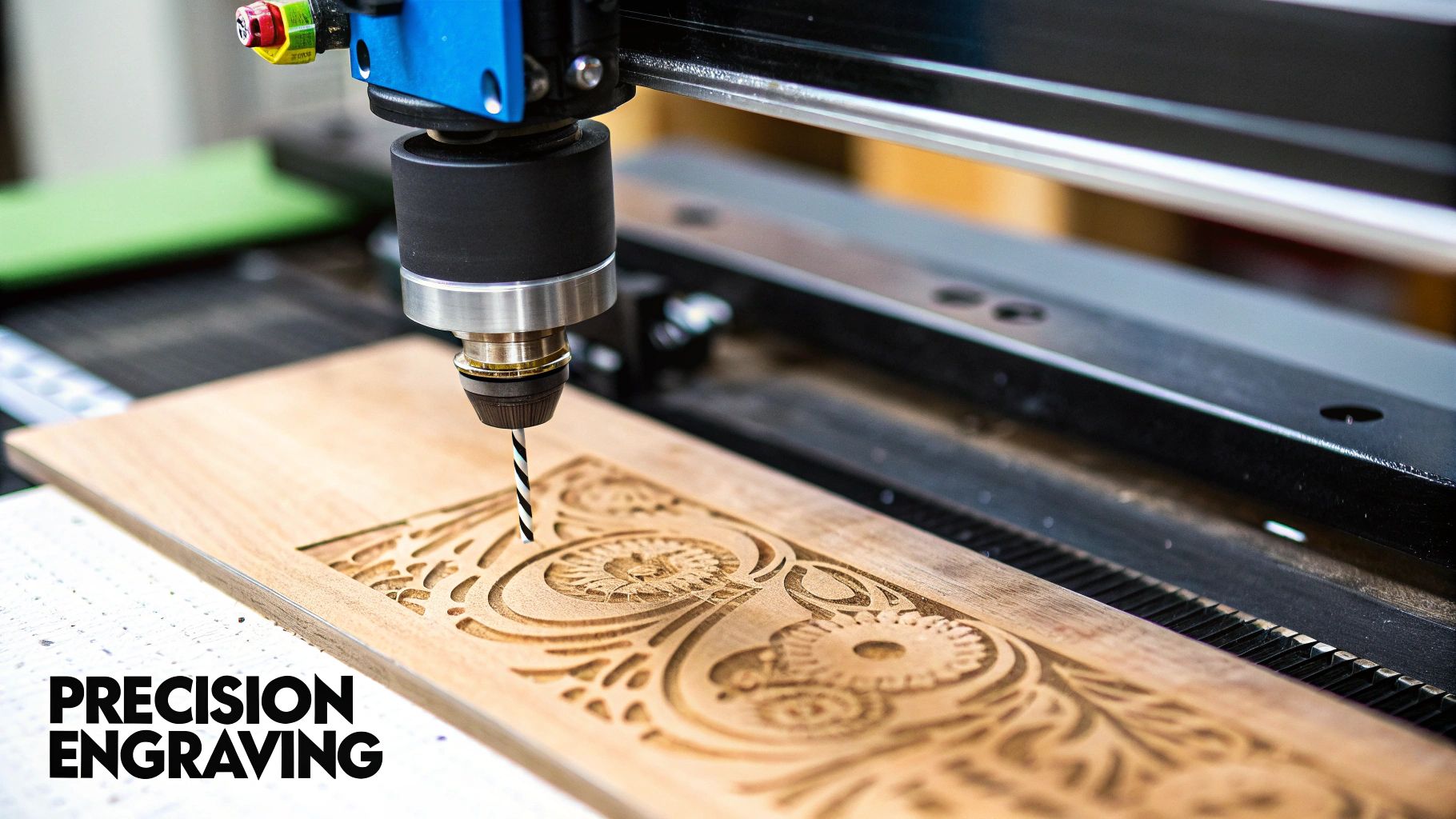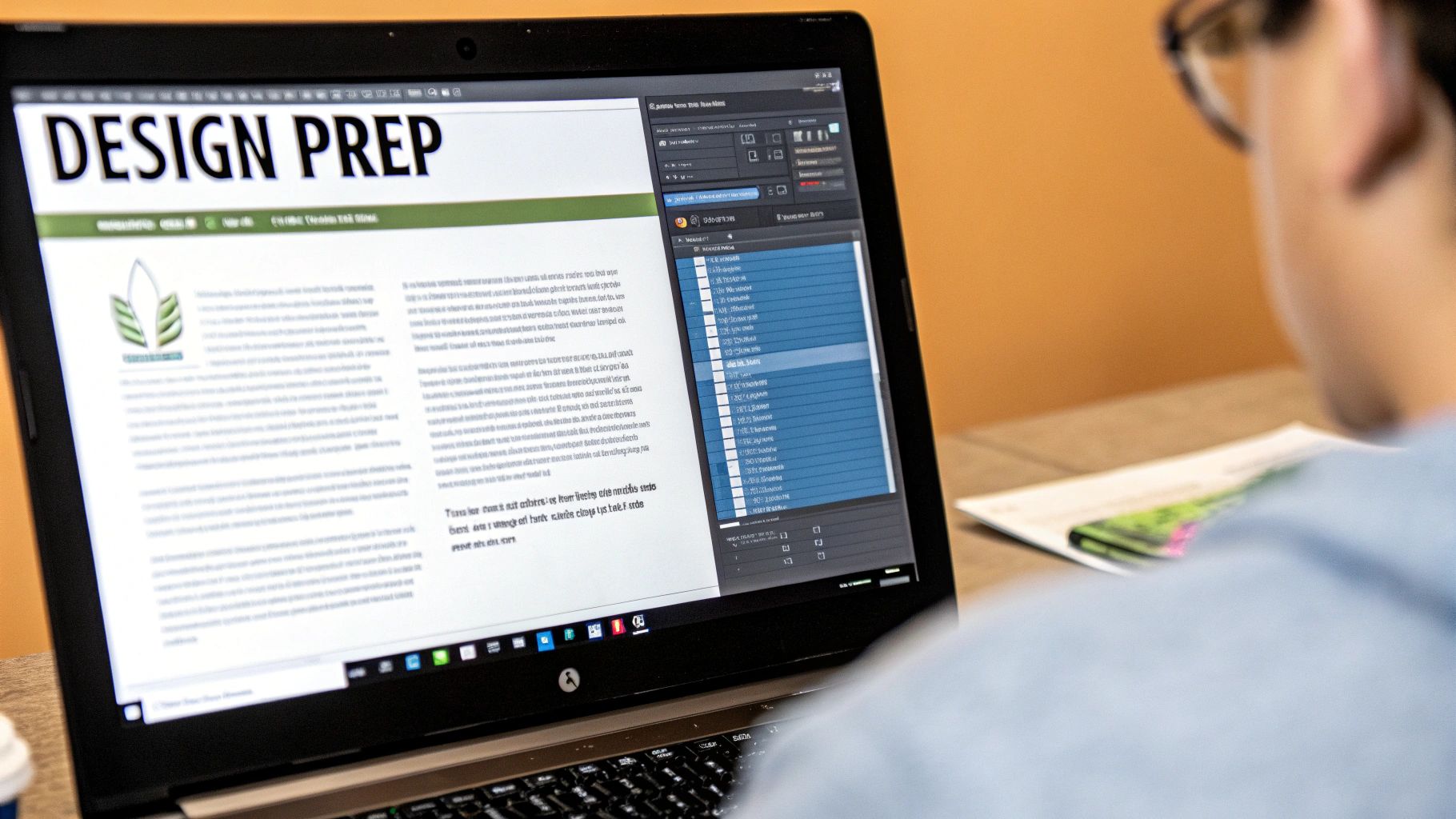Think of laser engraving not as printing, but as a form of high-tech, computer-guided sculpting. It uses an incredibly focused beam of light to permanently etch a design directly into an object's surface. Unlike ink, which sits on top of a material, an engraved mark is physically part of it, making it exceptionally detailed and durable. This is why it’s the go-to method for everything from industrial part marking to creating one-of-a-kind personalised gifts.
Unlocking the Power of Light
Let’s set aside the idea of a regular desktop printer that applies ink to paper. Laser engraving printing is what’s known as a subtractive process—it takes material away. Imagine a super-precise, automated chisel, and you’re getting close. A powerful, concentrated beam of light is aimed at a material, and the intense energy instantly vaporises or melts the surface in a tiny, targeted spot. This is what creates the permanent mark.
It all starts with a digital design file. You send this file to the laser system, much like you’d print a document. From there, sophisticated machinery, like the systems from industry leader Trotec Laser, takes over. The machine reads the digital file with pinpoint accuracy and guides the laser to trace out every detail of the design, carving it into the material layer by tiny layer. This precision ensures even the most complex logos, the smallest text, and intricate patterns come out perfectly, time after time.
The Two Main Laser Technologies
In the world of laser engraving, there are two main players, each with its own speciality when it comes to materials:
- CO2 Lasers: These are the workhorses for organic materials. If you’re working with wood, acrylic, glass, leather, or paper, a CO2 laser is your best friend, delivering a crisp, clean result.
- Fibre Lasers: When it comes to metals and certain hard plastics, fibre lasers are the undisputed champions. They’re perfect for creating ultra-durable marks on stainless steel, aluminium, and titanium, making them essential for industrial jobs like asset tags and serial numbers.
To get a clearer picture of where laser engraving shines, let's compare it to more conventional printing methods.
Laser Engraving vs Traditional Printing
This table offers a quick comparison, outlining the fundamental differences between laser engraving and conventional ink-based printing methods.
| Feature | Laser Engraving Printing | Traditional Printing (e.g., Inkjet/Screen) |
|---|---|---|
| Method | Subtractive; removes material with a laser beam. | Additive; applies a layer of ink or toner. |
| Durability | Extremely high; marks are permanent and resistant to wear, fading, and chemicals. | Varies; can scratch, fade, or wash off over time. |
| Material Compatibility | Wide range, including metals, plastics, wood, glass, leather, and stone. | Primarily paper, vinyl, and some fabrics; limited on hard or non-porous surfaces. |
| Precision | Exceptionally high detail and accuracy, perfect for intricate designs. | Good, but can be limited by ink bleed and substrate texture. |
| Consumables | No inks, toners, or solvents required. | Requires a continuous supply of ink or toner cartridges. |
| Setup | Digital setup is fast, ideal for one-offs and small batches. | Often requires screens or plates, making small runs less cost-effective. |
While traditional printing is fantastic for paper-based media and colourful graphics, laser engraving offers a level of permanence and precision that ink simply can't match, especially on hard-wearing materials.
This incredible technology is a cornerstone of modern manufacturing and personalisation, a fact reflected in its strong market growth. The Australian laser processing equipment market, which includes these systems, was valued at USD 235.16 million in 2023 and is projected to reach USD 552.01 million by 2032. To get a real sense of the process and see how laser engraving creates permanent designs on custom drinkware, this guide offers some fantastic insights.
How We Turn Your Designs Into Reality With Trotec Laser Systems
Ever wondered how a digital idea becomes a physical, engraved object? With modern laser systems, it’s a surprisingly straightforward journey that starts with your design.
You might create your concept in familiar graphics software like CorelDRAW or Adobe Illustrator. Once you’re happy with it, sending the file to one of our Trotec Laser machines is as simple as sending a document to your office printer. That’s when the real magic begins.
Our laser system's intelligent software reads every line, curve, and detail of your design. It then guides a high-precision beam of light, focusing it into a tiny, powerful point. This concentrated energy instantly vaporises the material's surface, leaving a permanent, perfect mark.
Think of it like using a magnifying glass to focus sunlight and burn wood, but with incredible, computer-guided precision. The laser moves with phenomenal speed and accuracy, flawlessly executing your design every single time.
The Core Workflow
This whole process is methodical, ensuring we get repeatable, high-quality results for any project. Whether we're working with timber, acrylic, or metal, the basic steps are the same—we just dial in the specific settings for each material.
This visual guide shows the essential flow for setting up any laser engraving job.

As you can see, everything starts with the material. Once we know what we're working with, we can determine the right laser power and machine to get the best possible result.
One of the biggest advantages of laser engraving is that it’s a non-contact process. Only the laser beam ever touches the material, so there’s no mechanical stress, no need for clamping, and no risk of warping delicate items. This makes it perfect for everything from intricate jewellery to sensitive electronic components.
It’s a clean, efficient process that produces consistent, high-quality results that older, traditional methods just can’t match. This blend of digital precision and physical permanence is what makes the technology so valuable across countless industries.
The Real-World Advantages of Laser Engraving
When it comes to marking materials, laser engraving offers some serious benefits that make it a standout choice for countless commercial and industrial jobs. We're not talking about buzzwords here; these are real, tangible outcomes in precision, permanence, and pure production efficiency that older methods just can't touch.
The level of detail a laser can achieve is honestly incredible.

This precision allows us to create the most intricate logos, tiny microscopic text, and even photo-quality images across a huge range of materials. Unlike ink that just sits on top, a laser physically etches the mark into the surface, making it a permanent part of the item itself.
Built to Last with Unbeatable Precision
One of the biggest wins is just how permanent the mark is. A laser-engraved design won’t fade, smudge, or wear away, even when it’s up against the harshest environments. This is exactly why it’s the go-to for industrial asset tags that need to stay readable for decades.
That toughness is matched by mind-blowing accuracy. Our Trotec Laser systems can reproduce a design with pinpoint precision, which is absolutely critical for high-end promotional gear where the brand’s integrity is on the line. For those tricky jobs with super fine details, our guide to laser engraving services has more tips on getting that perfect result.
At Evright.com, we harness the power of Trotec's world-class laser technology to deliver exceptional precision and quality. Our systems interpret digital designs and translate them into permanent, high-resolution marks on a vast range of materials, ensuring a perfect result every time.
Speed and Smart Production
Another massive plus is the speed and efficiency these modern systems bring to the workshop floor. Once we have the digital file ready, the laser can replicate the design thousands of times with perfect consistency and very little human supervision.
The fact that it’s a non-contact process is also a game-changer. Because only a beam of light touches the material, there's zero risk of the item warping or being damaged by mechanical force. This is a lifesaver when you're working with delicate materials or finished products. This one-two punch of speed and gentle handling really streamlines production and cuts down on waste.
It's no surprise the demand for these benefits is growing. Australia’s own laser engraving machine sector is expanding, feeding into a global market valued at USD 3.7 billion in 2024. That market is tipped to hit USD 6.8 billion by 2033, pushed along by automation and our collective love for personalised goods. This growth cements laser engraving as a must-have technology for modern industry.
Choosing The Right Material For Your Project
Getting the material right is the absolute cornerstone of any laser engraving project. It’s the dance between the laser beam and the surface that dictates the final result, and believe me, not all materials dance the same way. The big question often boils down to whether you need a CO2 or a fibre laser, which usually depends on one simple thing: is the material organic or inorganic?

This might sound a bit technical, but it’s crucial. Different lasers operate on different wavelengths, and materials absorb these wavelengths differently. Think of it like a key fitting into a lock—the material has to "accept" the laser’s energy to create a mark. This is why you can't just use one machine for everything, and it’s why premium systems from brands like Trotec Laser are often specialised for certain material groups.
Common Materials And Their Unique Finishes
The magic of laser engraving really comes to life when you see the different finishes it creates. Every material reacts in its own unique way when hit with that focused beam of light, giving it a signature look.
Here are a few popular choices we work with all the time and what you can expect:
- Wood: A CO2 laser beautifully burns the surface, leaving behind a dark, rustic mark that’s slightly recessed. The contrast is just fantastic.
- Acrylic: Instead of burning, the laser vaporises the material, creating an incredibly crisp and clean etch. It often leaves a sharp, frosted white finish.
- Glass: The laser doesn't really cut into glass; it creates tiny micro-fractures on the surface. This produces a stunning, elegant frosted effect you see on custom awards or drinkware.
- Leather: Engraving on leather gives you a really premium, tactile feel. It creates a darker, debossed effect that adds a touch of class to personalised items.
- Metals: This is where a fibre laser is a must-have. You can achieve anything from a light surface etch to a deep black anneal, where the laser’s heat changes the metal’s colour without removing any material.
Material And Laser Compatibility Guide
To make things a little easier, we’ve put together a quick guide. This table breaks down which laser we’d typically recommend for common materials and the kind of finish you can expect to see.
| Material | Recommended Laser Type | Expected Engraving Finish |
|---|---|---|
| Wood, Plywood, MDF | CO2 | Dark brown, burned recess |
| Acrylic (Cast & Extruded) | CO2 | Frosted, white, or clear polished edge |
| Glass & Crystal | CO2 | White, frosted surface etch |
| Natural Leather | CO2 | Darkened, debossed mark |
| Stainless Steel | Fibre | Dark annealed mark (blackening) or light etch |
| Anodised Aluminium | CO2 or Fibre | Bright white or silver mark (removes anodised layer) |
| Laminated Plastics | CO2 | Reveals core colour for high-contrast signage |
Of course, some jobs require a more specialised touch, especially when you’re trying to get a perfect finish on certain metal alloys. If you’re working with steel, for instance, our guide on how to perfectly engrave stainless steel dives much deeper into the nuances of this popular industrial material.
At the end of the day, matching the right laser technology to the right material is the secret sauce for a truly professional-grade result.
Where Laser Engraving Shines: Real-World Applications Across Australian Industries
This is where the theory hits the road. You can talk about precision and permanence all day, but the true value of laser engraving really comes to life when you see how it’s being used across Australia’s toughest industries.
It’s more than just a fancy way to mark a surface; it’s about creating permanent, reliable solutions that solve critical challenges where durability and compliance aren't just nice-to-haves—they're essential. From the red dust of a Pilbara mine site to a slick manufacturing hub in Melbourne, the need for identification that lasts is universal.

Industrial and Safety Applications
Think about the conditions on a heavy industrial site. Asset tags and compliance plates are constantly battling extreme heat, abrasion, and chemical spills. Your standard sticker or printed label doesn't stand a chance.
This is where laser engraving printing is a game-changer. By etching directly into metal or industrial-grade plastic, the mark becomes part of the component itself. It can't peel off, rub away, or fade. That means vital information like barcodes, serial numbers, and safety data stays perfectly readable for the entire life of the equipment.
It's the same story with high-visibility safety signage. To meet Australian safety standards, signs need to be clear and last for years. Lasers produce incredibly sharp, high-contrast text and symbols on durable materials that simply won't quit. And it's not just for industrial sites; for any business, mastering store signage design is key, and the precision of laser engraving delivers that premium, lasting quality.
This demand for tough, reliable marking is driving serious growth. The Australian printer market, which covers these laser technologies, was valued at USD 501.07 million in 2024 and is on track to hit nearly USD 578.08 million by 2034.
Creative and Commemorative Uses
But it's not all about the factory floor. The creative potential of a Trotec Laser machine is immense. Architects, for example, use them to build incredibly intricate and dimensionally perfect models, turning a digital blueprint into a stunning physical reality.
In the corporate world, it's about making a premium, lasting impression. A personalised award or gift engraved with a company logo has a tangible quality and permanence that a simple printed item just can't replicate.
Laser engraving offers a unique combination of permanence and elegance, making it the ideal choice for creating timeless memorial plaques that honour loved ones with dignity and grace.
This same versatility makes it perfect for crafting beautiful and enduring memorial plaques. The process allows for delicate scripts and detailed images, creating a finish that truly stands the test of time and provides a fitting tribute.
Whether it’s for industrial compliance or a heartfelt commemoration, the precision of laser engraving printing delivers every time. For anyone looking for local expertise, our team specialising in laser engraving in Adelaide is here to provide tailored solutions for all these applications and more.
Common Questions About Laser Engraving Printing
When you start digging into the world of laser engraving printing, a few questions always seem to pop up. Getting a handle on the finer details is the key to figuring out how the technology can bring your specific project to life.
We get these questions all the time, so we’ve put together some straightforward answers to the most common ones. Our goal is to arm you with the practical knowledge you need to make the right call, whether you’re looking at ultra-durable industrial asset tags or a finely detailed creative piece.
What Is The Difference Between Laser Engraving and Laser Etching?
It's a common point of confusion, and while many people use the terms interchangeably, there's a definite technical difference between the two.
Laser engraving is a process that physically vaporises the material, carving out a deep, permanent mark you can actually feel with your finger. That depth is precisely why it’s the go-to for applications where you need extreme durability—think serial numbers on heavy machinery parts that need to last a lifetime.
Laser etching, on the other hand, is a much shallower process. It essentially melts the very top layer of the material, causing it to expand and create a raised mark. It's faster and often used when you need to mark a surface without removing a significant amount of material. High-end systems like our Trotec Lasers can execute both processes with incredible precision; it all comes down to adjusting the power and speed settings in the software.
Can Laser Engraving Printing Produce Colours?
This is a great question. In the traditional sense, laser engraving printing doesn't add colour like an inkjet printer does. The final "colour" of the mark is created by the material's reaction to the intense heat of the laser beam. When you engrave wood, for instance, you're left with that classic dark brown, scorched look.
That said, some materials can create some really striking colour contrasts. Laser marking certain metals, for example, can produce a deep, permanent black through a process called annealing, which is a form of oxidation. Another popular technique is "colour-filling," where we first engrave a design and then fill the recessed area with paint for a vibrant finish. There are also specialised materials, like TroLase laminates, which are designed with a core layer of a different colour that gets revealed when the top surface is engraved away.
How Do I Prepare A Design File For A Trotec Laser Machine?
You'll be pleased to hear it's a pretty straightforward process, not all that different from sending a document to your office printer.
You can create your design in any vector-based graphics software you're comfortable with, like CorelDRAW or Adobe Illustrator. If you're after photorealistic results, raster images like JPEGs are also perfect for engraving.
There are just a couple of key things to keep in mind. You'll want to set any lines you want cut to a very thin stroke (often called a 'hairline') and use distinct RGB colour codes to tell the machine what to do—for example, red for cutting and black for engraving. Once your design is ready, you simply hit the 'print' command and choose the Trotec laser driver. From there, a simple interface lets you dial in all the crucial settings like power, speed, and material type before you send the job to the engraver.
At Evright.com, our expertise lies in turning your digital files into perfectly engraved realities. Our advanced Trotec systems ensure every mark is made with precision and permanence. See how our precision engraving and asset labelling solutions can work for you at https://evrightindustrial.com.au.



Recent Comments